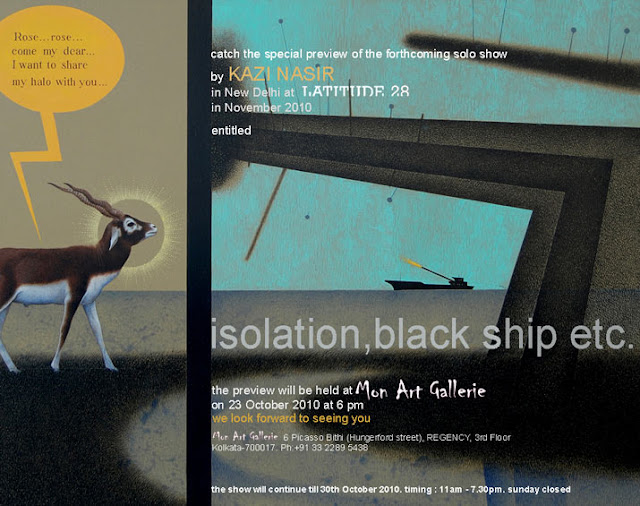isolation, black ship etc.

A Cautionary Tale
A dystopia. A warning society. A cautionary tone. A locale where all that prevent are gigantic iron structures; glimpses of Romanesque buildings; a sleeping man; set in a landscape that is desolate and devoid of any human habitat, occasionally traversed by war ships and tankers at a distant horizon; – only an uncomfortable silence spells the looming presence of the ominous.

Kazi Nasir’s (b 1970) oeuvre takes the viewer in a land of disorientation. In a land where the spectator, fails to locate the identifiable and finds himself in a horizon, beyond the limit of the known and in the prison of a dehumanising world.

In his current exhibition, titled Isolation, Black Ship, etc., war planes; monstrous exhaust pipes; self-portraits of the artist dressed up in the most contemporary way; roses with thorns; fire emitting tankers; fiery celestial bodies raining from the heaven; war ships; smoky skies; distant blue horizons speak of an uncharted future. A disturbingly shallow space obstructed with gigantic architectural fragments that act as grids or bars obtrusively resisting the viewer’s path/gaze,forming thick frames, cutting away the picture plane into polyptych.
---- Oindrilla Maity Surai, Kolkata, October 2010
--------------------------------------------------------------------------------------------------------------------------------------------------------------------------------
(21st June to 18th July 2010)
As the exhibits in this show refer the artists from different generations, this exhibition will hold the understandings of visual language in art of two polar distant generations.
Since a specific time span has particular sets of mediation to convey the story of that time, every period of time defers from other for this reason. Nevertheless, compiling stories from different times, there is an attempt to juxtapose them to evaluate the anomaly and the unanimity of it. Thus, at an extent of a discussion, we have come to the title for the exhibition as ‘ABREAST TOTEMS’.

VIEW THE SHOW AT WWW.MONARTGALLERIE.COM
--------------------------------------------------------------------------------------------------------------------------------------------------------------------------------
OF MYTH METAPHOR AND ALLEGORY
This exhibition is based on four artists who were born in the 1970s and three of who have shifted from elsewhere in the country and are currently based in Baroda. Their works are consequently bearers of a multitude of idioms that are homespun in a way (sourced from their own regional/ institutional practices) and as well as picked up from their second home (Baroda).
The works of Pappu Bardhan, Prithwiraj Mali and Sharmi Chowdhury offer scope to study the nature of the idioms that have fused so finely in their renditions, improvising on an already established visual language particular to Baroda.
What is also important in understanding their works is a tendency to move along a specific trajectory unique to these artists, all of who were born in the decade of the 70s. As a result, they have faced the stupendous experience of the electronic media and the gradual blurring of set notions and cultural limits by the global phenomenon, gradually and essentially being part of them.
The question that arises at this point is how is the national situation being reflected in the works of these artists? What is nature of the national allegory in a multinational capitalistic third world? In a genre of Cultural Revolution, is there a significant shift in the works of these artists from their traditional upbringings? How do they address the urban myth?
It is only the beginning of an incalculable possibility which modern myths, allegories and metaphors can scope themselves. Solitude, detachment, sarcasm, demystification, a utopian aspiration and even a certain kind of sentimentality of a new genre have just begun to gain momentum through the eyes of these young artists, who have posited themselves at a prime point of transition, between trend and tradition.
THE WAY WE ARE
The ways in which we access our past determine the collective thoughts of a nation. This is even more significant in a post -colonized nation and the post-colonized subject. The proposed show is based in the context of ‘historical citizenship’ in the Indian sub-continent, and is an attempt to map the various nuances of thoughts as they reshape themselves in the different corners of the country.
This is an endeavour to trace how a nation incarnates its own history by forging its identity; wedding the past to the present; whether we then tend to exhibit a considerable regionalism in addressing our ‘national thoughts’ and finally, what are the historically experienced truth of the colonial/post-colonial nations? Our identity is determined by the way we reconsider the nature of our national identity. This is to find out how do we do so? If it is the national past that we refer to in the act of accessing the past, it is a mandate that we acquire and preserve socialist narratives and national allegories of our own. Without them we risk it all to a social danger looming large.
As observes Geeta Kapoor: “without the socialist narrative and national allegories, what is it that will sustain a symbolic order of collectivities forged in the name of the holy by the religious bigots of the day?... With the politics of emergent ethnicities, with the emergence of non-contextual appropriation of traditions and the obscurantism of religious militancy, we are increasingly held to ransom by a fundamentalist or racial consciousness”











